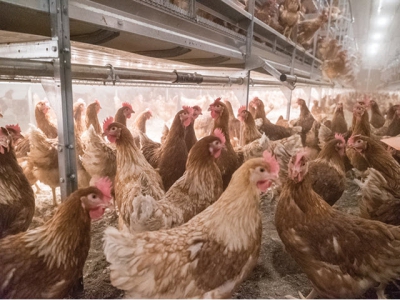Lighting may help with poultry welfare issues

Industry professional discusses the impact lighting has on cannibalism, skeletal injuries and piling
Danielle Botting, DVM. MPH, technical services veterinarian with Hy-Line North America, LLC discussed the effects of lighting on animal welfare at the 2018 Live Production, Welfare & Biosecurity Seminar in Nashville, Tennessee, held on September 18.
Among the top animal welfare concerns impacted by lighting were cannibalism, skeletal injuries and piling, she explained.
Cannibalism and pecking
Cannibalism and pecking are the No. 1 animal welfare issue that can be impacted by lighting, she explained. “I see this the most in cage-free and enriched colonies,” she said.
While most birds tend to be aggressive and cannibalistic to some degree by nature, it can also be related to other causes. For instance, exposure to natural light, salt deficiency, inadequate nesting space, high bird density, available enrichments, inadequate ventilation, timely mortality removal and poor beak trim can all be to blame.
Botting suggesting reducing light intensity as an effective method for reducing cannibalism. “Lighting is not going to fix everything, but it is a tool that can be used,” she said.
Using dimmable bulbs is a valuable option, she explained. If an operation doesn’t have dimmable bulbs, it can use every other bulb. The goal though should be to sustain uniform dimming.
“When changing lighting, it is important to have management present to assess the flock after changes are made,” she said.
Other solutions to cannibalism are increasing salt in the birds’ diets, frequently removing dead birds and improving beak trim for future flocks.
Skeletal issues
Skeletal injuries include but are not limited to broken keel bones, wings and legs. These issues can be results of the bird getting caught in equipment.
She explained that in cage-free environments producers may see an increase in injuries related to flying/landing accidents. Botting’s presentation referenced a quote from the Coalition for Sustainable Egg Supply that said, “between 9 and 21 percent of flights in an aviary ended in failed landings.”
Other skeletal injuries may come from mishandling by employees.
For cage-free systems, using different lighting styles can be used to train the birds to move up and down. This method is successful when management begins gradually shutting off lights. Management can also keep brighter lights over the center aisles and in front of feed/water, perching areas, while keeping nesting areas darker, she explained.
Piling issues
Piling issues are like cannibalism. It can be a result of poor conditioning as pullets. It may also result from stress from weather, construction, inadequate amount of nesting space, high bird densities and inadequate ventilation.
To successfully use light as a management tool for piling, producers should use the sunrise/sunset dim setting to reduce stress, she explained.
Different lighting levels
Using different levels of brightness in the house can encourage certain behaviors. For instance, brighter areas over perches represent daytime rest while darkness inside nest may help reduce cannibalism.
For different lighting levels to be successful, employees must be trained in properly detecting health issues, injuries and mortality within the flocks.
Botting emphasized that every operation should have a basic light meter in order to determine what light intensity birds are comfortable with. Light measurements should be taken at bird level in different areas of the housing system.
Có thể bạn quan tâm
 Encouraging Hens to Lay in Nests
Encouraging Hens to Lay in Nests The occurrence of non-nest eggs (floor and slat eggs) will lead to increased labour requirements, reduced hatching egg quality and a potential reduction
 How pie pans can help fight poultry diseases
How pie pans can help fight poultry diseases A thought exercise can help veterinarians and farmers determine the actual causes of multifactorial diseases like necrotic enteritis.
 Slow-growth chicken consumer opinions can be swayed
Slow-growth chicken consumer opinions can be swayed Consumer willingness to pay more for products from slower-growing broilers depends largely on the information they receive, study reveals.